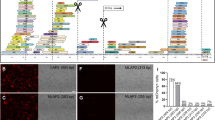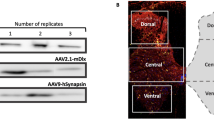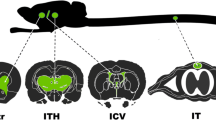Abstract
The ability to regulate transgene expression is likely to be important in the use of gene transfer to treat diseases of the central nervous system (CNS). In order to achieve regulatable gene expression we created a replication-incompetent genomic herpes simplex vector containing a RU486-inducible transactivator and a lacZ reporter gene under transcriptional control of a minimal promoter. Reporter gene expression from the vector was regulated by administration of RU486 in vitro and in vivo. In cell culture half maximal expression was achieved with 10−8 M RU486, and maximal expression was achieved by 24 h. Following stereotactic inoculation of the vector into rat hippocampus, expression was increased 150-fold by i.p. administration of RU486. This demonstrates that the RU486 system functions as a tight on/off switch for regulating expression of a transgene delivered to the brain via an HSV vector.
This is a preview of subscription content, access via your institution
Access options
Subscribe to this journal
Receive 12 print issues and online access
$259.00 per year
only $21.58 per issue
Buy this article
- Purchase on Springer Link
- Instant access to full article PDF
Prices may be subject to local taxes which are calculated during checkout
Similar content being viewed by others
Author information
Authors and Affiliations
Rights and permissions
About this article
Cite this article
Oligino, T., Poliani, P., Wang, Y. et al. Drug inducible transgene expression in brain using a herpes simplex virus vector. Gene Ther 5, 491–496 (1998). https://doi.org/10.1038/sj.gt.3300612
Received:
Accepted:
Published:
Issue Date:
DOI: https://doi.org/10.1038/sj.gt.3300612
Keywords
This article is cited by
-
Evaluation and optimization of the administration of a selectively replicating herpes simplex viral vector to the brain by convection-enhanced delivery
Cancer Gene Therapy (2011)
-
Regulation of endogenous gene expression using small molecule-controlled engineered zinc-finger protein transcription factors
Gene Therapy (2007)
-
Viral vectors for gene delivery to the nervous system
Nature Reviews Neuroscience (2003)
-
Bcl-2 expression by retrograde transport of adenoviral vectors with Cre-loxP recombination system in motor neurons of mutant SOD1 transgenic mice
Gene Therapy (2001)
-
Gene therapy in the CNS
Gene Therapy (2000)



